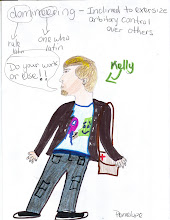Covering
the finale “Prophecy Girl,” in which the world does not end, but season 1 does.
Like I said last time, I think BtVS works best when subtly mapping high
schooler issues onto the supernatural, and right on cue comes “Prophecy Girl,”
the season 1 finale in which the world is ending. It’s ending because the
Master will soon escape, heralded by dark omens of dogs birthing snakes and the
earth being rent asunder, and it is so written in the Codex that when Buffy
faces him she shall die. The end of the world! Also it’s ending because Xander
asks Buffy to the spring dance, as like a Date date, and she re-uh…rejects his
advances. Argh, it’s the end of the world! And then Willow gets fed up with
being a perpetual doormat and tells Xander, her bestest bestie, off (in a very
Willow doormat-y way, at least). OMG, it’s the end of the world!
The stakes are a bit higher for
Buffy, obviously—while all three feel like they could just die, Buffy’s the
only one who does. But there is a connecting thread of being consumed by despair
and emotional turmoil that is much more effective than had the Master more
obviously represented despair and the Anointed One emotional turmoil. Xander
mopes in his room. Willow keeps trucking on, but she is extra morose about it.
Buffy shouts at Giles and rejects her Campbellian call again, says she quits
and tries (half-heartedly) to run away. But they are all roused when they are
confronted by greater problems, and in the process find that their earlier
drama was just that—trivial drama. Despite what Codexes and hormones say, the
world is only going to end if you let it.
Prophecy is a pretty regular trope
in supernatural and horror fiction , so it
was inevitable BtVS would involve
them—indeed, these episodes have all opened with an explanation that sounds
awfully prophetic (“In each generation, there is a Chosen One!”). The show
comes from the Eowyn school of thought, treating prophecies like
Deconstructionist semantic traps, rife with mistranslations, dependent on weird
contexts, often duplicitously made, and unable to account for modernity or
facts on the ground. Here, the Master barely gets to gloat over how the
prophecy tricks Buffy before it turns on him and screws him royally, because
Aurelius or whoever didn’t account for artificial respiration.
But before that, the prophecy serves
to force Buffy to confront her mortality like she hasn’t had to in a while. An
early death is one of the less desirable Slayer perks, a likely consequence of
fighting evil all the time, and is one of the first she mentions in “Welcome to
the Hellmouth,” so we know it weighs upon her, but she doesn’t mention it often
while she’s fighting evil, probably because the show is fun, and moroseness isn’t
very fun (Significant Look). But the prophecy isn’t a hypothetical inevitability
(so she, and Giles, and Angel, and Jenny think), it’s quite concrete, all but
time stamped. And she reacts in obvious, and legit ways—lashing out, and trying
to flee. It’s short lived, though, as Willow stumbles upon a tableaux of what
awaits the world should Buffy actually quit, so she rallies. I’m not dissuaded
from my thoughts on the show’s real foundation by the fact that the ensuing
scene, where she has to knock Giles unconscious to keep him from eschewing the
prophecy by fighting the Master on her behalf, is probably the episode’s best.
The Master himself. I discussed some
of the character’s issues in “Angel,” and they’re brought into stark relief
here. His set is real cheap, and has to be shot with the actors in close-up.
Know where you should shoot an action bit? Typically, it isn’t in close up. SMG
and her double (the difference often hilariously obvious in HD) have been
really great with Buffy’s necessary physicality, it’s mainly the way it’s
filmed that’s been the issue. Anyway, the Master has spent most of the season
on this cheap set, removed from any action, and the limited number of episodes
in turn limited his appearances, keeping him from developing much presence. He’s
felled more by budget and time than execution. Here, however, is the episode
they decided should claim the lion share of the budget, with vampire crowd
shots, Cordelia smashing walls with her car, and the delightfully cheesy
Hellspawn (unlike the mantis lady, the 4th or 9th Doctor
would be proud to face the Hellspawn).
And with that, season 1 ends. I don’t
think it rocks too many boats to say there are grand things on the horizon,
though.
Apex
Episode: Pretty sure this defies convention, but I’m going with “Out of
Mind, Out of Sight.”
Nadir
Episode: I mean, it has to be “I Robot, You Jane,” right? Yes,
yes it does.
Season
4 Costuming Theory Check-In: Since we’re in a very mid-90s minimalism, no
one stands out as too egregious. Cordelia and Jenny show up with slightly
crimped hair (a look which I recall may have come back for about a week and a
half?), lots of silk, and all of Xander’s printed shirts are awful, but, eh,
this is mostly just dated, and not even dated enough you’d notice if you passed
any of these people on the street. Except for Xander’s awful print shirts, of
course. The Season 4 Theory remains intact.


No comments:
Post a Comment